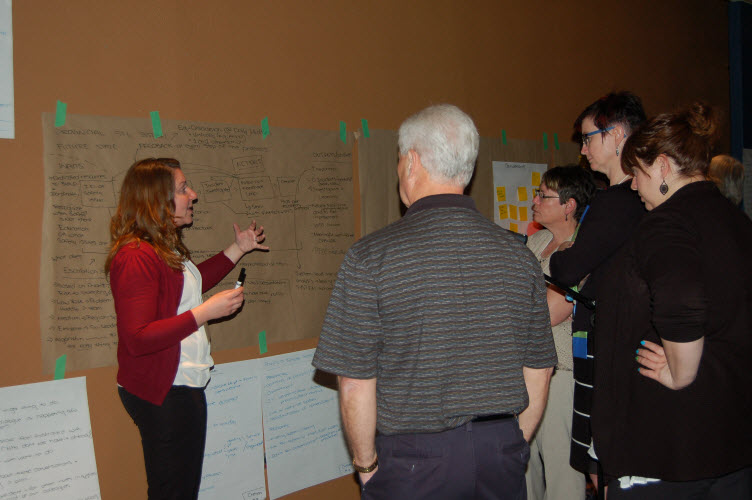At last week’s visioning event, small groups, involving leaders, providers, and patients, talked about what an ideal Safety Alert / Stop the Line system should look like.
One of the Saskatchewan health care system’s 5-year goals is to establish a culture of safety, where everyone – staff, patients, family members – feels they have a role in eliminating errors. On May 28, nearly 150 people from across the system gathered in Regina to set out a bold vision for a key element critical to building that culture – a province-wide Safety Alert / Stop the Line system. Participants included senior leaders, physicians, nurses, pharmacists, unit managers, infection control practitioners, occupational health and safety consultants, and patient and family advisors.
A Safety Alert / Stop the Line system not only allows, but expects, workers, patients, or family members who see the potential for harm or injury to report it immediately and halt the activity, in other words to “stop the line.” The organization is then obligated to respond according to pre-established protocols. For example, the protocol might require a very serious event to be reported up to a senior manager who would resolve the problem within 24 hours.
Valerie Phillips, Director of the Ministry’s Patient Safety Unit, says the individual safety initiatives that Saskatchewan has already implemented — such as the surgical safety checklist – are important, but alone are not enough. “To see real progress, we must change our underlying culture, the way we feel and think about patient and staff safety.”
Last week’s event featured presentations on the BC Patient Safety and Learning System, and a similar system used at Park Nicollet Health System in Minnesota. The Saskatchewan Cancer Agency and Saskatoon Health Region also shared the current models they are testing and learning from.
According to Suann Laurent, CEO of Sunrise Health Region and owner of the patient safety hoshin, the number of individuals and organizations involved in the day demonstrates how our health system is increasingly thinking and acting as one. “Never before have we had the focus and the tools to deliver on such a laudable goal,” says Laurent. “This excites and moves me deeply, to think that we can affect future generations in such a positive way.”
Health Regions and the Cancer Agency defined the “current state” of their respective safety systems, then participants, working in small groups, identified what kind of system they’d like to achieve provincially.
Saskatoon’s Heather Thiessen was one of 15 patient and family advisors who took part. She said having patients and family members at the table brought a different energy to the conversation. “Automatically, people were asking: what about the patient?” says Thiessen. “It was amazing. I don’t think we would have seen that even five or 10 years ago.”
While patient safety and staff safety have traditionally been regarded as separate priorities, a culture of safety means preventing harm to anyone. “That’s an important message for everyone working in the system,” says Phillips. “We care about the safety of patients, of course, and we also care about your safety, as a health care worker.”
Last week’s event yielded lots of great ideas. The next step will be consolidating these into an action plan to achieve the new vision. “Saskatoon Health Region has already begun developing a “model line” on one unit,” says Phillips. “But what works well in a tertiary centre may not just ‘plug and play’ in Swift Current or La Loche. We need everyone to stay involved, and help to create a provincial system where we all see our own role.”
For more information about this work, contact Valerie Phillips (306-787-3542 / valerie.phillips@health.gov.sk.ca).



